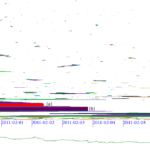
The paper “Visualizing Sparse Internet Events: Network Outages and Route Changes” was accepted by WIV’12 in Boston, MA (available at http://www.isi.edu/~johnh/PAPERS/Quan12b.html).
From the abstract:
To understand network behavior, researchers and enterprise network operators must interpret large amounts of network data. To understand and manage network events such as outages, route instability, and spam campaigns, they must interpret data that covers a range of networks and evolves over time. We propose a simple clustering algorithm that helps identify spatial clusters of network events based on correlations in event timing, producing 2-D visualizations. We show that these visualizations where they reveal the extent, timing, and dynamics of network outages such as January 2011 Egyptian change of government, and the March 2011 Japanese earthquake. We also show they reveal correlations in routing changes that are hidden from AS-path analysis.
Citation: Lin Quan and John Heidemann and Yuri Pradkin. Visualizing Sparse Internet Events: Network Outages and Route Changes. In Proceedings of the First ACM Workshop on Internet Visualization. Boston, MA. November, 2012. <http://www.isi.edu/~johnh/PAPERS/Quan12b.html>.



![Visualization of low-rate periodicity, before and after installation of a keylogger. [Bartlett11a, figure 3]](http://ant.isi.edu/blog/wp-content/uploads/2011/04/Bartlett11a_icon-227x300.png)